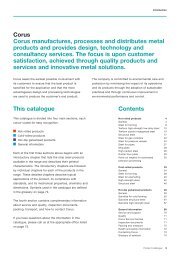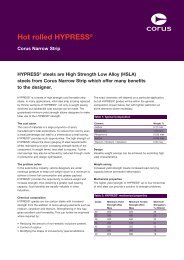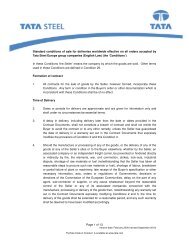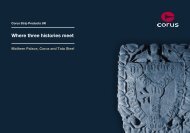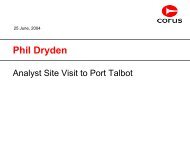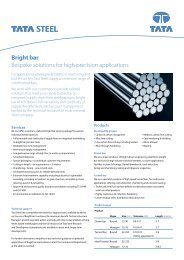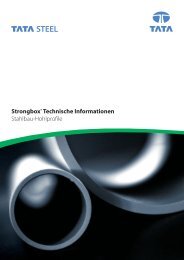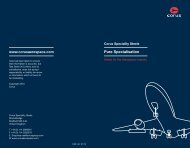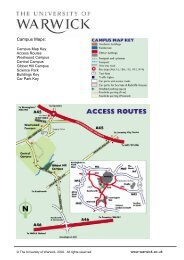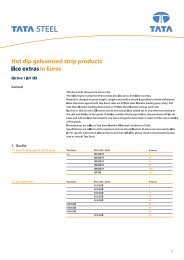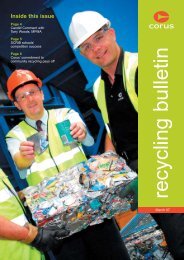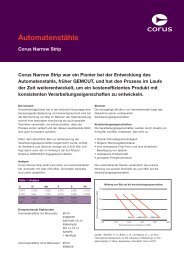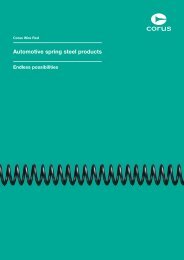Celsius® 355: the ultimate choice Hot structural hollow ... - Tata Steel
Celsius® 355: the ultimate choice Hot structural hollow ... - Tata Steel
Celsius® 355: the ultimate choice Hot structural hollow ... - Tata Steel
Create successful ePaper yourself
Turn your PDF publications into a flip-book with our unique Google optimized e-Paper software.
Celsius ® <strong>355</strong>: <strong>the</strong> <strong>ultimate</strong> <strong>choice</strong><br />
<strong>Hot</strong> <strong>structural</strong> <strong>hollow</strong> sections
Contents<br />
03 Introduction<br />
04 Celsius® <strong>355</strong> explained<br />
06 An informed <strong>choice</strong><br />
12 Benefits of using Celsius® <strong>355</strong><br />
13 In summary<br />
14 Structural <strong>hollow</strong> section comparison guide<br />
02
Celsius® <strong>355</strong> The Ultimate Choice<br />
CELSIUS ® <strong>355</strong><br />
The quality of <strong>hollow</strong> sections is critical to <strong>the</strong><br />
performance of structures. Not all <strong>hollow</strong><br />
sections are <strong>the</strong> same. Using <strong>the</strong> wrong type<br />
of section may reduce <strong>the</strong> performance of<br />
your structure.<br />
Celsius® <strong>355</strong> is <strong>the</strong> <strong>ultimate</strong> hot-finished <strong>structural</strong> <strong>hollow</strong> section. Developed to perform in <strong>the</strong><br />
most arduous conditions, Celsius® <strong>355</strong> has outstanding properties and is <strong>the</strong> only <strong>choice</strong> where<br />
failure is not an option.<br />
Why choose Celsius® <strong>355</strong>?<br />
Key differences between Celsius® <strong>355</strong> and cold-formed <strong>hollow</strong> sections.<br />
• Homogeneity<br />
• High ductility<br />
• Resistance to fracture<br />
• Virtual absence of residual stress<br />
• Section properties<br />
• Buckling strength<br />
• Dimensional stability<br />
• Fire resistance<br />
Quality progression<br />
Material performance<br />
Ultimate confidence<br />
Enhanced aes<strong>the</strong>tics<br />
High formability<br />
Stress relieved<br />
Low temperature suitability<br />
Fully tested performance and traceability<br />
<strong>355</strong> MPa yield<br />
Consistency of dimensions<br />
Galvanisable<br />
Fully killed steel<br />
Strongbox®235 Hybox®<strong>355</strong><br />
Cold Formed EN10219<br />
Celsius®<strong>355</strong><br />
<strong>Hot</strong> Finished EN10210<br />
Key<br />
Strongbox®235<br />
Hybox®<strong>355</strong><br />
Celsius®<strong>355</strong><br />
03
Celsius® <strong>355</strong> The Ultimate Choice Celsius® <strong>355</strong> explained<br />
CELSIUS ® <strong>355</strong> EXPLAINED<br />
EN10210 – <strong>Hot</strong>-finished <strong>structural</strong> <strong>hollow</strong> sections<br />
ASTM A501 – <strong>Hot</strong>-formed welded carbon steel <strong>structural</strong> tubing<br />
Celsius® <strong>355</strong> is a hot-finished, welded <strong>structural</strong> <strong>hollow</strong> section. It is<br />
supplied in accordance with both <strong>the</strong> European Standard EN 10210 and<br />
<strong>the</strong> American Standard ASTM A501. It far exceeds <strong>the</strong> minimum<br />
specified requirements, with guaranteed minimum yield strength of <strong>355</strong><br />
N/mm 2 (51.5 ksi). Celsius® <strong>355</strong> complies with and exceeds <strong>the</strong><br />
classification EN10210 S<strong>355</strong> J2H. It can also be produced to meet<br />
EN10210 S<strong>355</strong> NH as an optional extra.<br />
The majority of <strong>the</strong> Celsius® <strong>355</strong> range is produced using <strong>the</strong> high<br />
frequency induction (HFI) welding process (dimensions up to 400mm x<br />
400mm square, 500mm x 300mm rectangular and 508mm circular). The<br />
submerged arc welding (SAW) process is used to manufacture larger<br />
section sizes (dimensions up to 800mm x 800mm square, 750mm x<br />
500mm rectangular and 2134mm circular).<br />
All Celsius® <strong>355</strong> hot-finished <strong>structural</strong> <strong>hollow</strong> sections:<br />
• Are formed at a high, normalising temperature while fully austenitic<br />
• Have a uniform grain structure and hardness over <strong>the</strong> whole section<br />
• Have mechanical properties that are stable and uniform over <strong>the</strong><br />
whole section<br />
Celsius® <strong>355</strong> is not simply stress-relieved but fully formed at a high<br />
temperature, usually in excess of 840°C. As <strong>the</strong> material cools, a phase<br />
transformation takes place, producing a fine-grained, uniform ferrite<br />
structure with consistent properties. Under EN10210, stress relieving of<br />
cold-formed products at lower temperature is allowed, enabling<br />
minimum standards to be met. However, this does not produce a phase<br />
change and leaves a varying grain structure throughout <strong>the</strong> section.<br />
Therefore, areas of micro<strong>structural</strong> inhomogeneity will exist and<br />
mechanical properties will also vary around <strong>the</strong> section. These<br />
properties will vary at <strong>the</strong> same points normally found in cold-formed<br />
<strong>hollow</strong> sections.<br />
Celsius® <strong>355</strong> is manufactured differently to cold-formed <strong>hollow</strong> sections<br />
(European Standard EN10219 and American Standard ASTM A500). Coldformed<br />
sections are shaped at ambient temperature without fur<strong>the</strong>r heat<br />
treatment, meaning <strong>the</strong>y have a non-uniform microstructure. The<br />
mechanical properties in <strong>the</strong> weld heat-affected zones and in <strong>the</strong> corners<br />
of square and rectangular sections are inferior to those in <strong>the</strong> body of <strong>the</strong><br />
section. These differences are illustrated in Figures 1 and 2, which show<br />
photomicrographs of <strong>the</strong> weld areas and schematic maps of Vickers<br />
Hardness values in <strong>the</strong> corners. Celsius® <strong>355</strong> has low and uniform<br />
hardness in <strong>the</strong> corners whereas a typical cold-formed section has<br />
hardness of 180 in <strong>the</strong> centre of <strong>the</strong> thickness, peaking to over 200 and<br />
250 on <strong>the</strong> outside and inside surfaces respectively.<br />
Figure 1:<br />
Figure 2:<br />
Micro of weld area<br />
Micro of weld area<br />
Celsius®<strong>355</strong> has uniform grain structure with low hardness.<br />
Cold-formed <strong>structural</strong> <strong>hollow</strong> sections have varying grain structure with<br />
hardness peaks.<br />
04
For traceability and quality of <strong>the</strong> material for each specific <strong>structural</strong><br />
application, all Celsius®<strong>355</strong> is certified to EN10210 and American<br />
Standard ASTM A501. In accordance with EN10204, we issue Inspection<br />
Certificate Type 3.1.<br />
Figure 3:<br />
Typical inspection certificate type 3.1 produced to EN10204<br />
05
Celsius® <strong>355</strong> The Ultimate Choice An informed <strong>choice</strong><br />
AN INFORMED CHOICE<br />
The difference between Celsius®<strong>355</strong>, cold-formed and coldformed<br />
stress-relieved products. Celsius®<strong>355</strong> shows different<br />
characteristics over a range of properties because of <strong>the</strong><br />
manufacturing process. The key differences are as follows:<br />
Homogeneity<br />
Celsius® <strong>355</strong> has a uniform grain structure and similar properties right<br />
across <strong>the</strong> section. Vickers Hardness values are <strong>the</strong> same in <strong>the</strong> flat,<br />
corner and seam weld zones (Figure 4). Cold-formed sections have<br />
greater brittleness in <strong>the</strong> corner and seam weld zones compared to <strong>the</strong><br />
body of <strong>the</strong> section. This is illustrated in Figure 4 by peaks of hardness.<br />
Ductility<br />
Celsius® <strong>355</strong> has high ductility at all points and in all directions. So, even<br />
after yield, <strong>the</strong>re is still a reserve of ductility beyond <strong>the</strong> unloading line,<br />
such as in areas local to connection points. The tensile test is used to<br />
measure ductility using specimens in a longitudinal direction, from <strong>the</strong><br />
centre of <strong>the</strong> flat face or away from <strong>the</strong> weld in circular sections.<br />
However, in cold-formed sections, ductility is substantially reduced in<br />
<strong>the</strong>se areas and <strong>the</strong> standard test will not show this. In general, bodies<br />
under load need to be able to resist a certain level of multidirectional<br />
stresses and this cannot be guaranteed in cold-formed sections.<br />
Figure 4:<br />
Figure 5:<br />
Vickers Hardness<br />
400<br />
Nominal Stress<br />
Cold-Formed<br />
<strong>Hot</strong> Finished<br />
300<br />
200<br />
Unloading Line<br />
100<br />
0<br />
Corner A<br />
Weld<br />
Corner B<br />
Corner C<br />
Corner D<br />
Nominal Strain<br />
Inside Surface<br />
Key<br />
Key<br />
<strong>Hot</strong><br />
Cold<br />
<strong>Hot</strong><br />
Cold<br />
Typical plot of hardness values on inside surface of square <strong>structural</strong> <strong>hollow</strong><br />
sections.<br />
Schematic stress: strain plots for test specimens taken from corners of Celsius® <strong>355</strong><br />
and cold-formed <strong>structural</strong> <strong>hollow</strong> sections indicating differences in ductility.<br />
06
Figure 6:<br />
Photograph of stages of <strong>the</strong> tensile test indicating ductility achieved by test<br />
specimen taken from Celsius®<strong>355</strong>.<br />
07
Celsius® <strong>355</strong> The Ultimate Choice An informed <strong>choice</strong><br />
Resistance to fracture<br />
Whilst maintaining a low yield ratio (yield/tensile), Celsius® <strong>355</strong> has<br />
good energy absorption and high resistance to fracture. These<br />
properties ensure much better endurance under load, particularly cyclic<br />
or dynamic impact load. In <strong>the</strong> standard Charpy test, Celsius® <strong>355</strong><br />
achieves uniformly high absorbed energy values and low transition<br />
temperatures.<br />
When tested, impact specimens are taken from a longitudinal direction<br />
and <strong>the</strong> centre of <strong>the</strong> flat face or away from <strong>the</strong> weld in circular sections.<br />
This means <strong>the</strong> substantially reduced fracture resistance in <strong>the</strong> corners<br />
or weld zones is not indicated in cold-formed <strong>hollow</strong> sections (see<br />
figures 7 and 8). So, when specifying materials, it is important to take<br />
into account <strong>the</strong> cold-formed <strong>hollow</strong> section’s planes of relative<br />
weakness of resistance to fracture ei<strong>the</strong>r side of <strong>the</strong> weld lines. Our<br />
Celsius® <strong>355</strong> products substantially exceed <strong>the</strong> minimum impact values<br />
set out in EN10210 and ASTM A501. Also, <strong>the</strong> yield ratio is approximately<br />
0.74 for <strong>the</strong> larger sizes (not specified in <strong>the</strong> standard).<br />
Figure 7:<br />
A & C = 150sq/100sq bird-beak joint<br />
B = 150sq/120sq traditional joint<br />
D = 150sq/120sq bird-beak joint<br />
Energy Dissipation Ratio<br />
600<br />
500<br />
400<br />
300<br />
200<br />
100<br />
0<br />
Key<br />
0<br />
<strong>Hot</strong><br />
A<br />
B<br />
C<br />
D<br />
200 400 600 800 1000<br />
Ductility Ratio<br />
Cold<br />
Energy dissipation versus ductility plots for X-joints under reverse loading. This<br />
indicates superior performance of <strong>the</strong> hot-finished sections (see Footnote 1).<br />
Reproduced by kind permission of <strong>the</strong> University of Nottingham<br />
08
Figure 8:<br />
<strong>Hot</strong> Absorbed Energy (J)<br />
140<br />
120<br />
100<br />
80<br />
60<br />
40<br />
20<br />
Cold Absorbed Energy (J)<br />
140<br />
120<br />
100<br />
80<br />
60<br />
40<br />
20<br />
0<br />
-80<br />
-40 0<br />
40 80<br />
0<br />
-80 -40 0<br />
40 80<br />
Temperature (°C)<br />
Temperature (°C)<br />
Key<br />
Key<br />
<strong>Hot</strong>, Flat Face<br />
<strong>Hot</strong>, Corner<br />
Parent Strip <strong>Steel</strong><br />
Cold, Flat Face Cold, Corner Parent Strip <strong>Steel</strong><br />
Typical Charpy toughness: temperature graph for specimens taken from <strong>structural</strong> <strong>hollow</strong> sections.<br />
Figure 9:<br />
Absorbed Energy (J)<br />
350<br />
350<br />
300<br />
250<br />
200<br />
Flat face (longitudinal)<br />
Corner (interior)<br />
300<br />
250<br />
200<br />
Corner D (exterior)<br />
Flat face (longitudinal)<br />
Flat face (transverse)<br />
150<br />
Flat face (transverse)<br />
150<br />
100<br />
Corner (exterior)<br />
100<br />
Corner B (exterior)<br />
50<br />
0<br />
27 Joules<br />
50<br />
0<br />
27 Joules<br />
Weld (transverse)<br />
Weld (longitudinal)<br />
-60 -45 -30 -15 0 15 30 45 60<br />
-60 -45 -30 -15 0 15 30 45 60<br />
Temperature (°C)<br />
Temperature (°C)<br />
Key<br />
<strong>Hot</strong><br />
Cold<br />
Charpy toughness versus temperature plots for specimens taken on flat faces, in longitudinal and transverse directions, at welds and in corners (see Footnote 2).<br />
Footnotes:<br />
1. Hall, S. and Owen, J. The behaviour of <strong>hollow</strong> section connections under<br />
seismic loading. The Structural Engineer vol. 82/4 February 2004.<br />
2. Kosteski, N., Packer J.A. and Puthli R.S. 2003. Notch toughness of cold-formed<br />
<strong>hollow</strong> sections. Cidect Report 1B-2/03.<br />
09
Celsius® <strong>355</strong> The Ultimate Choice An informed <strong>choice</strong><br />
Residual stress<br />
Celsius® <strong>355</strong> is produced virtually free of residual stress in all directions.<br />
These residual stresses, sometimes in combination with stresses due to<br />
weld shrinkage, may have <strong>the</strong> effect of bringing forward <strong>the</strong> point of<br />
failure and increasing <strong>the</strong> likelihood of heat-affected zone and liquid<br />
metal cracking.<br />
Section properties<br />
In almost all sizes, Celsius® <strong>355</strong> has corner radii less than 2 x thickness<br />
(2T) which is better than <strong>the</strong> maximum allowable corner radii specified<br />
in EN 10210. Small corner radii offer superior section properties, reduced<br />
fabrication costs and an improved appearance. In addition, <strong>the</strong> material<br />
properties may be exploited. The use of plastic design is not limited by a<br />
lack of ductility which is an issue when using cold-formed sections.<br />
Figure 10:<br />
Outside<br />
-300N/m 2 -300N/m 2<br />
Inside<br />
+300N/m 2 +300N/m 2 +300N/m 2 +300N/m 2<br />
-300N/m 2 -300N/m 2<br />
0N/m 2 0N/m 2<br />
0N/m 2 0N/m 2<br />
Figure 11:<br />
Photograph comparing corner radii,<br />
from left to right, in hot-finished, coldformed<br />
stress-relieved and cold-formed<br />
<strong>structural</strong> <strong>hollow</strong> sections.<br />
+300N/m 2 +300N/m 2<br />
0N/m 2 0N/m 2<br />
-300N/m 2 -300N/m 2<br />
+300N/m 2 +300N/m 2<br />
0N/m 2 0N/m 2<br />
-300N/m 2 -300N/m 2<br />
Figure 12:<br />
Photograph showing <strong>the</strong> difference in<br />
profile between hot-finished (left) and<br />
cold-formed (right) <strong>structural</strong> <strong>hollow</strong><br />
sections.<br />
Outside<br />
-300N/m 2 -300N/m 2<br />
Inside<br />
+300N/m 2 +300N/m 2 +300N/m 2 +300N/m 2<br />
-300N/m 2 -300N/m 2<br />
0N/m 2 0N/m 2<br />
0N/m 2 0N/m 2<br />
+300N/m 2 +300N/m 2<br />
+300N/m 2 +300N/m 2<br />
0N/m 2 0N/m 2<br />
0N/m 2 0N/m 2<br />
-300N/m 2 -300N/m 2<br />
-300N/m 2 -300N/m 2<br />
Key<br />
<strong>Hot</strong><br />
Cold<br />
Plots of typical residual stresses found on <strong>the</strong> outside and inside surfaces.<br />
10
Buckling strength<br />
Celsius® <strong>355</strong> offers improved resistance to buckling compared to coldformed<br />
sections. The buckling strengths are up to 35% greater than<br />
cold-formed sections of <strong>the</strong> same dimensions. When designing with<br />
cold-formed sections, a lower buckling curve must be used to calculate<br />
strength. This allows for residual stresses and <strong>the</strong> reduced plastic<br />
deformation of <strong>the</strong> material.<br />
Dimensional stability<br />
Celsius® <strong>355</strong> is stable and not prone to distortion during cutting,<br />
welding or o<strong>the</strong>r fabrication procedures. No special precautions are<br />
required for shot-blasting, galvanising or welding near corners.<br />
However, cold-formed sections have high levels of residual stresses and<br />
are more likely to distort during processing and fabrication.<br />
Fire resistance<br />
Unlike cold-formed sections, Celsius® <strong>355</strong> has consistent and reliable<br />
performance in <strong>the</strong> event of a fire and will not suffer from sudden losses<br />
in yield strength on heating. By filling <strong>the</strong> section with concrete (with or<br />
without fibre or steel reinforcement) and/or applying an external<br />
protection, most periods of fire rating can be achieved.<br />
Figure 13:<br />
Reduction Factors %<br />
1.0<br />
0.8<br />
0.6<br />
0.4<br />
0.2<br />
a<br />
c<br />
Figure 14:<br />
A. B.<br />
0<br />
Key<br />
0.2<br />
0.9 1.6<br />
2.3 3.0<br />
Appropriate non-dimensional slenderness<br />
<strong>Hot</strong><br />
Cold<br />
C. D.<br />
Buckling curves from EC3 Part 1.1 showing ‘a’ curve for hot-finished and ‘c’ curve<br />
for cold-formed <strong>structural</strong> <strong>hollow</strong> sections.<br />
Fire resistance may be achieved by A. Intumescent external protection, B. Concrete<br />
filling of <strong>the</strong> inside, C. Filling toge<strong>the</strong>r with an intumescent external protection or<br />
D. Concrete filling with reinforcement.<br />
11
Celsius® <strong>355</strong> The Ultimate Choice Benefits of using Celsius® <strong>355</strong><br />
BENEFITS OF USING CELSIUS ® <strong>355</strong><br />
Structural frames using Celsius®<strong>355</strong> can be designed to provide<br />
<strong>the</strong> following benefits:<br />
Economy<br />
Celsius® <strong>355</strong> provides savings in time and money because of its built-in<br />
fire resistance, coordinated outside dimensions and efficient shape. For<br />
example:<br />
• Heavily-loaded columns can still be small enough to fit between<br />
partitions. This saves space and reduces <strong>the</strong> amount of fire protection<br />
required.<br />
• Larger columns can arrive on site fully finished, with fire resistance<br />
designed-in and, if required, needing only splice connections to be<br />
made on site.<br />
Resistance to shock loads<br />
Celsius® <strong>355</strong> has <strong>the</strong> ability to absorb large amounts of energy, both as<br />
bare steel sections and as composite elements filled with concrete. For<br />
example, joints in a triangulated frame structure under axial load show<br />
good ductility and energy absorption under cyclic loading (Figure 16).<br />
Also, in a moment frame with correctly-designed joints, <strong>the</strong> ductile<br />
elements give energy-absorbing characteristics to <strong>the</strong> whole frame.<br />
Even at low temperatures, Celsius® <strong>355</strong> has high fracture toughness,<br />
toge<strong>the</strong>r with a low yield ratio.<br />
Figure 16:<br />
Ductile behaviour<br />
Celsius® <strong>355</strong> has high ductility. When correctly jointed as a frame, it<br />
exhibits ductile <strong>structural</strong> behaviour. This means <strong>the</strong>re is still strength in<br />
<strong>the</strong> frame even after gross deformation has taken place. For example, in<br />
<strong>the</strong> unexpected removal of an element under extreme loading<br />
conditions or in <strong>the</strong> heating or cooling phase in a fire (Figure 15).<br />
Figure 15:<br />
Moment frames can be designed to have ductile and energy-absorbing<br />
characteristics under extreme loading conditions.<br />
Frames can be designed to exhibit ductile behaviour, offering alternative load<br />
paths in <strong>the</strong> event of unexpected removal of columns.<br />
Resistance to temperature effects<br />
Celsius® <strong>355</strong> has good performance at both ends of <strong>the</strong> temperature<br />
scale. At low temperatures, yield, elasticity and fracture toughness are<br />
maintained. At high temperatures, <strong>the</strong>se properties reduce slowly and in<br />
a predictable way. Under fire conditions, increased safety is provided<br />
due to <strong>the</strong> ductile behaviour and <strong>the</strong> slower loss of properties in <strong>the</strong><br />
heating and cooling phase.<br />
12
IN SUMMARY<br />
Celsius® <strong>355</strong> cannot be substituted for cold-formed <strong>hollow</strong> sections of<br />
<strong>the</strong> same dimensions without a full re-analysis of <strong>the</strong> design.<br />
• At high or low temperatures, Celsius® <strong>355</strong> generally has higher loadbearing<br />
capacities and better performance than cold-formed<br />
<strong>structural</strong> <strong>hollow</strong> sections of similar dimensions.<br />
• Under extreme loading conditions, Celsius® <strong>355</strong>, when correctly<br />
detailed in frames, is inherently more robust. For example: fire,<br />
collision, impacts, explosions or earthquakes.<br />
• Celsius® <strong>355</strong> presents less risk during processing and fabrication. This<br />
is because it is less prone to cracking and more predictable in use<br />
than cold-formed sections.<br />
13
Celsius® <strong>355</strong> The Ultimate Choice Structural <strong>hollow</strong> section comparison guide<br />
STRUCTURAL HOLLOW SECTION<br />
COMPARISON GUIDE<br />
Manufacture<br />
Celsius®<strong>355</strong><br />
Shaped within <strong>the</strong> normalising range, at a temperature<br />
in excess of 840°C .<br />
Cold-formed<br />
Shaped at ambient temperature without any fur<strong>the</strong>r<br />
heat treatment.<br />
Micro-structure<br />
Uniform fine-grained structure over <strong>the</strong> whole section.<br />
Non-uniform grain size and structure around <strong>the</strong><br />
section.<br />
Homogeneity<br />
Hardness and tensile properties are uniform over <strong>the</strong><br />
whole section.<br />
Hardness and tensile properties vary around <strong>the</strong><br />
section.<br />
Ductility<br />
Excellent ductility so substantial reserves of plasticity<br />
after yield point has been exceeded.<br />
Only moderate reserves of plasticity after yield point<br />
has been exceeded.<br />
Resistance to fracture<br />
Impact properties are uniform over <strong>the</strong> whole section.<br />
Non-uniform impact properties around <strong>the</strong> section and<br />
in <strong>the</strong> weld area (also in <strong>the</strong> corners of square and<br />
rectangular sections).<br />
Residual stress<br />
Virtually free of residual stress.<br />
Areas of high stress throughout <strong>the</strong> section.<br />
Section properties<br />
Small radii corners for optimum section properties;<br />
easier welding and improved appearance.<br />
Larger radii corners than hot-finished sections to avoid<br />
brittleness, giving inferior section properties.<br />
Buckling strength<br />
Design uses European buckling ‘a’ curve and optimum<br />
section properties, giving <strong>the</strong> highest strut capacity.<br />
Designed to <strong>the</strong> European buckling curve ‘c’ with<br />
reduced section properties, giving reduced strut<br />
capacity.<br />
Dimensional stability<br />
Not prone to twisting or distortion when heated or<br />
mechanically treated.<br />
Can be prone to distortion when subjected to fur<strong>the</strong>r<br />
processing due to residual stress levels.<br />
Fire properties<br />
Strength reduces slowly and evenly under fire<br />
conditions.<br />
Loss of strength can be unpredictable due to cold<br />
working and residual stresses.<br />
Testing<br />
Testing and sampling procedures mean that<br />
mechanical test results are representative of <strong>the</strong><br />
properties of <strong>the</strong> section as a whole.<br />
Testing and sampling procedures mean that<br />
mechanical test results are NOT representative of <strong>the</strong><br />
properties of <strong>the</strong> section as a whole.<br />
Tolerance and finish<br />
Manufactured to a high standard of surface finish with<br />
excellent control of wall thickness and shape superior<br />
to that typically offered by comparable seamless.<br />
Manufactured to a high standard of surface finish with<br />
excellent control of wall thickness and shape.<br />
Indicative section profile<br />
14
Cold-formed and heat-treated<br />
Shaped at ambient temperature <strong>the</strong>n stress relieved<br />
(below normalising temperature).<br />
Non-uniform grain size and structure around <strong>the</strong><br />
section.<br />
Hardness and tensile properties vary around <strong>the</strong><br />
section.<br />
Better ductility than cold-formed sections but inferior<br />
to hot finished sections.<br />
Improved impact properties compared to cold-formed<br />
sections but inferior to hot-finished sections.<br />
Low levels of residual stress.<br />
Larger radii corners than hot-finished sections to avoid<br />
brittleness, giving inferior section properties.<br />
Can be designed to <strong>the</strong> European buckling ‘a’ curve<br />
but with reduced section properties.<br />
Has reasonable resistance to distortion when subject<br />
to fur<strong>the</strong>r processing.<br />
Strength reduces slowly but unevenly under fire<br />
conditions.<br />
Testing and sampling procedures mean that<br />
mechanical test results are NOT representative of <strong>the</strong><br />
properties of <strong>the</strong> section as a whole.<br />
Manufactured to a high standard of surface finish<br />
with excellent control of wall thickness and shape.<br />
15
www.tatasteel.com<br />
While care has been taken to ensure that <strong>the</strong><br />
information contained in this brochure is accurate,<br />
nei<strong>the</strong>r <strong>Tata</strong> <strong>Steel</strong> Europe Limited, nor its subsidiaries,<br />
accept responsibility or liability for errors or for<br />
information which is found to be misleading.<br />
Copyright 2011<br />
<strong>Tata</strong> <strong>Steel</strong> Europe Limited<br />
<strong>Tata</strong> <strong>Steel</strong><br />
PO Box 101<br />
Weldon Road<br />
Corby<br />
Northants<br />
NN17 5UA<br />
United Kingdom<br />
T: +44 (0)1536 404561<br />
F: +44 (0)1536 404111<br />
marketing@tatasteel.com<br />
English Language TST05:1000:UK:03/2011




